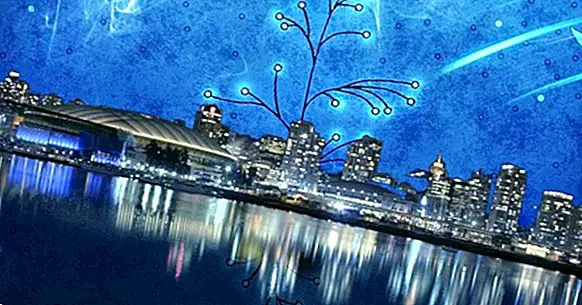The meaning of dreams according to Jungian psychology
From ancient times to the present day, different cultures have considered dreams as a gateway to a magical dimension that allows us to predict the future or communicate with spirits or other immaterial entities. Many of these beliefs are still part of contemporary popular culture even in the West .
In the year 1900 the creator of psychoanalysis Sigmund Freud published his book The Interpretation of Dreams, introducing his study into modern science and not as a form of communication with metaphysical entities, but as the symbolic expression of the unconscious of individuals .
From Freud's pioneering research on dreams, methodologies and conceptualizations related to the interior of some psychological schools were developed, such as the individual psychology of Alfred Adler or the psychology of Gestalt; However, the Jungian analytical psychology of Carl Gustav Jung is probably the perspective that has come to place greater emphasis on the interpretation of dreams as a fundamental part of the psychotherapeutic process. Let's see how the subject of dreams is addressed from this school.
What is the origin of dreams?

In Jungian psychology, dreams are considered as products of nature ; emanations of that creative force that is implicit in the conformation of the cells, in the tissues of the leaves of the trees, in our skin and in the cultural and artistic expressions. They are therefore attributed an intrinsic wisdom that is expressed through symbolic images.
For the Swiss psychiatrist Carl Jung, creator of analytical psychology, this creative force makes use of the impressions of the day before, the diurnal remains and our vital experiences to build the images and stories of our dreams.
The matrix of dreams: the archetypes of the collective unconscious
According to Jung, the Freudian approach to the unconscious as a reservoir of repressed sexual desires was not enough to account for those contents that do not relate to the personal history of individuals.
Jung realized that frequently in the delusions and hallucinations of his psychiatric patients, as well as in the dreams of people in general, themes, stories and characters emerged spontaneously, once examined and interpreted, they came to bear a surprising similarity with the mythological narratives that have accompanied humanity in different times and places. Jung argued that such similarity can not always be attributed to a direct or indirect contact between the individual and these ideas during their daily acts, so he inferred that these stories and symbols emerge from a common creative source, which he called the collective unconscious .
The typical motifs of mythological narratives, delusions and dreams they are for Jung symbolic expressions of universal patterns of behavior and the meaning we humans inherited as a species, which he called archetypes.
The archetypes are considered the psychic correlates of the biological instincts and function as mechanisms of self-regulation, integration and promotion of psychic development. They are also seen as containers and transmitters of wisdom common to all humanity.
Dreams as a representation of the archetype of the hero
The archetypal myth of the hero's journey (humble and miraculous birth, individual called to a mission, encounter with the master, interaction with allies and adversaries, trials, fight against evil, descent to the underworld, treasure meeting, marriage with the princess etc.) that is found in the structure of many ancient and contemporary stories, it is considered the symbolic manifestation of the process of psychic transformation that all individuals they are driven to perform throughout their lives.
This transformation is directed to the unfolding of the singular potentials of each individual, to the experience of his most genuine personality, of his vocation, of his singular contribution to the world. Accompanying this process of transformation, called the process of individuation, is the goal that Jungian psychotherapy proposes.
From the Jungian theory, variations and fragments of the mythical narrative of the hero are represented every night in our dreams by means of the way in which the archetypes are incarnated in the individuals, that is, the affective complexes.
Dreams as personification of affective complexes
The complexes are a set of ideas and thoughts with a strong emotional charge that are formed from personal experiences related to the theme of some archetype.The paternal complex, for example, is nourished by the personal and singular experiences that we have had with our own father and with other father figures, always under the background of the archetype of the universal "father".
Always according to Jung, the complexes are the constitutive elements of our psyche and behave like sub-personalities that are activated in certain circumstances of the external or internal world. Thus, an emotion disproportionate to the context (jealousy, desire for power, envy, falling in love, fear of failure or success) could be the indication that we are acting under the influence of a complex, and that our interaction with reality find mediated by this. The intensity in the activation of a complex conditions the degree of subjectivity that we project in people and external circumstances in a given situation.
The role of complexes
The complexes have the ability to personify themselves in our dreams , and they are constituted according to Jung in the writers, directors, actors and scenes of our oneiric world.
While we dream, we can then converse a wise old man represented by some professor or teacher that we admire; we are confronted with our shadow under the clothes of some acquaintance or neighbor who is irritating to us; We received a miraculous help from a silent childhood companion. The archetype of the shaman or healer may be represented by a doctor or by our therapist.
We have erotic relations with contemporary heroes or heroines. We cross obstacles, flee from murderers, we are victims and victimizers; we fly, we climb sacred mountains; we get lost in labyrinths, the house is destroyed in an earthquake, we survive floods, we die and sometimes we are reborn with another body; We return again and again to the university or school to present an exam of some subject that has remained pending. All experiences as real as those of waking life.
It is considered then that in most times the characters and situations of our dreams represent aspects of ourselves that need to be integrated and recognized.
A constant crossing
From Jungian psychology, dreams are the dramatization of our journey to the depths, in search of our treasure, of our most genuine being. It is in a series of dreams, rather than in an isolated dream, where the different stages of that journey are shown.
Further, Jung realized that the process of psychic transformation, also expressed in the myth of the hero, also had correspondences in the descriptions of the alchemical transformation , whose images sometimes also emerged spontaneously in dreams.
What are the dreams for?
According to Jung's ideas, dreams allow us to access the symbolic and profound meaning of our life experiences . They would be a symbol, in the sense of re-union, bridge, with the unique needs of the psyche, and that is why Jung believed that they transmit possible paths of action before the questions that have accompanied humanity since its inception.
In Jungian psychology, therapeutic work with dreams is seen as a tool that helps in the identification of our complexes and their gradual awareness. From this current it is believed that working with dreams helps to recognize patterns of behavior and relationships that may be problematic.
How do dreams act?
For Jungian psychology, the psyche functions as a self-regulated system with a tendency towards the balance of opposing elements (conscious-unconscious, light-darkness, feminine-masculine) in increasingly complex and integrated states. Dreams, like any other expression of the unconscious, such as symptoms, they would have a purpose and function within that process of integration and psychic evolution .
In view of the above, Jungian psychology does not focus on the origin of dreams, for example, some repressed desire, but on its purpose. That is to say, it is questioned about what a particular dream seeks to influence in relation to the psychic development of people.
The archetypal dreams
Dreams whose archetypal images are more evident and which find it difficult to find personal associations were called by Jung as great dreams. According to his ideas, great dreams or archetypal dreams usually precede vital circumstances that involve great qualitative transformations such as adolescence, maturity, marriage, a serious illness or death.
Archetypal dreams can sometimes be more related to collective phenomena than with the subjective life of people.
How are dreams interpreted?
A characteristic of dreams is that they are confusing and irrational . However, for Jungian psychology, dreams do not disguise, veil or censor the contents they transmit, as Freudian psychoanalysis considers it, but they express deep, complex and paradoxical knowledge that is unattainable to rational approximation through metaphors, analogies and correspondences of their images.
By expressing oneself through a symbolic language, its translation or interpretation is necessary. Jung considered that dreams fulfill their function even if we do not remember or understand them, but that their study and interpretation increases and accelerates their effectiveness.
Beyond the literal
The interpretation of dreams implies an opening to the symbolic consciousness , also called poetic, which allows access to the deep dimension of events, both the internal and external world, beyond its literalness. This idea is maintained throughout the phases of dream interpretation that are described below.
The contextualization
Bearing in mind that the unconscious is considered a compensating factor for our conscious attitudes, the first step to interpret a dream from Jungian psychology is the contextualization , which consists of inquiring about the thoughts, values and feelings of the dreamer with respect to the themes related to the dream.
The associations
Later we proceed to identify the personal significations and associations that evoke to the dreamer the images of his dream.
The fact that the images of a dream have an individual significance according to the personal history of each person, is reason why from the Jungian perspective the use of dictionaries of dream meanings is discouraged .
Although there are typical reasons in dreams, these must be addressed from the particular context of each individual. The schematized meanings, instead of broadening the comprehension gaze, usually limit and literalize what is quite toxic.
The amplification
The contextualization and identification of personal meanings provides the basis for choosing symbolic material from mythology, folklore and art that may be conducive to amplifying the sense of dream.
The amplification consists of go to images of universal symbology related to sleep , contributing meanings that broaden the comprehensive framework of our personal dramas and that offer possible paths of action based on human experience accumulated over thousands of years.
A synthesis
Afterwards, we try to make a synthesis of the multiple meanings that have emerged during the process. In response to the polysemic nature of dreams, interpretations they are provided as tentative hypotheses that can be more or less confirmed through a series of dreams .
The role of the therapist
In addition to using knowledge in mythology, folklore, comparative religions and village psychology, Jung considered that to properly interpret dreams, the analysts had to undergo a didactic analysis in order that their own complexes did not interfere in the interpretations of your patients' dreams. The interpretation of dreams is an activity that is carried out jointly between the analyst and the patient and only makes sense within the framework of this interaction.
In the early stages of a Jungian analysis the therapist usually has a more active role in this activity, but it is expected that the openness and permeability to the contents of the unconscious is one of the learning that the patients are unfolding throughout the analysis. The symbolic perspective that allows us to understand the messages of our dreams is then considered a resource that patients can count on once the psychotherapeutic process has ended.
Bibliographic references:
- Franz, M-L (1984). About dreams and death. Barcelona: Editorial Kairós.
- Franz, M.-L. ., & Boa, F. (1997). The road of dreams: Dr. Marie-Louise von Franz in conversations with Fraser Boa. Santiago de Chile: Cuatro Vientos Editorial.
- Jung, C. G. (1982). Psychic energetics and essence of the dream. Barcelona: Paidós.
- Jung, C. G. (1990a). The relationships between the Self and the Unconscious. Barcelona: Editorial Paidós.
- Jung, C. G. (1991a). Archetypes and collective unconscious. Barcelona: Editorial Paidós
- Jung, C. G. (2001). The complexes and the unconscious. Barcelona: Editorial Alliance



















